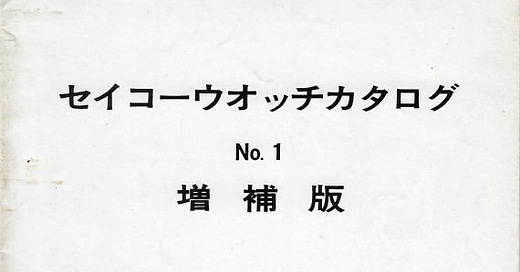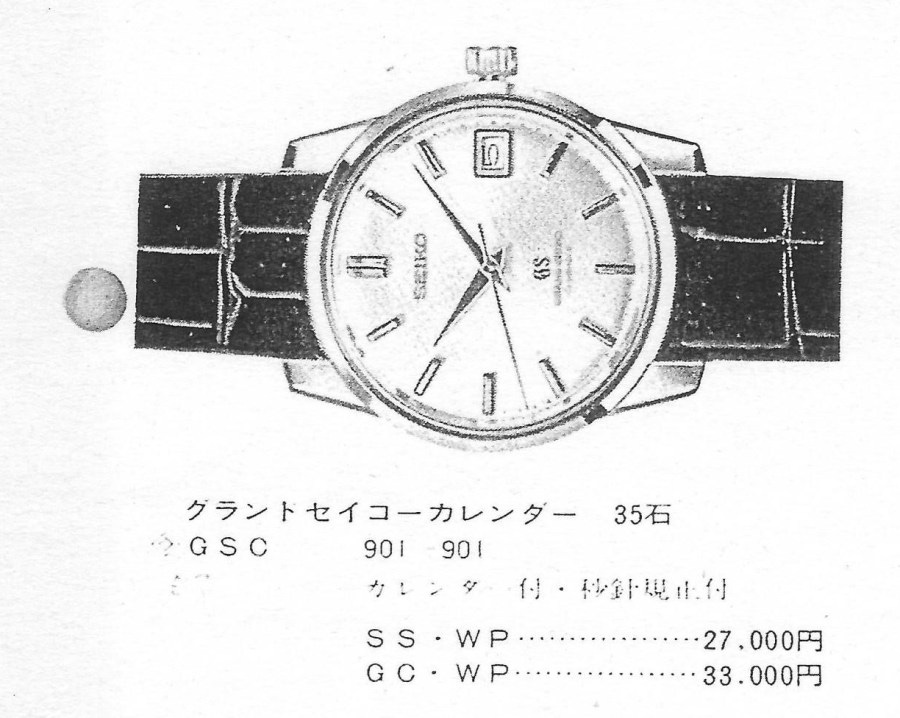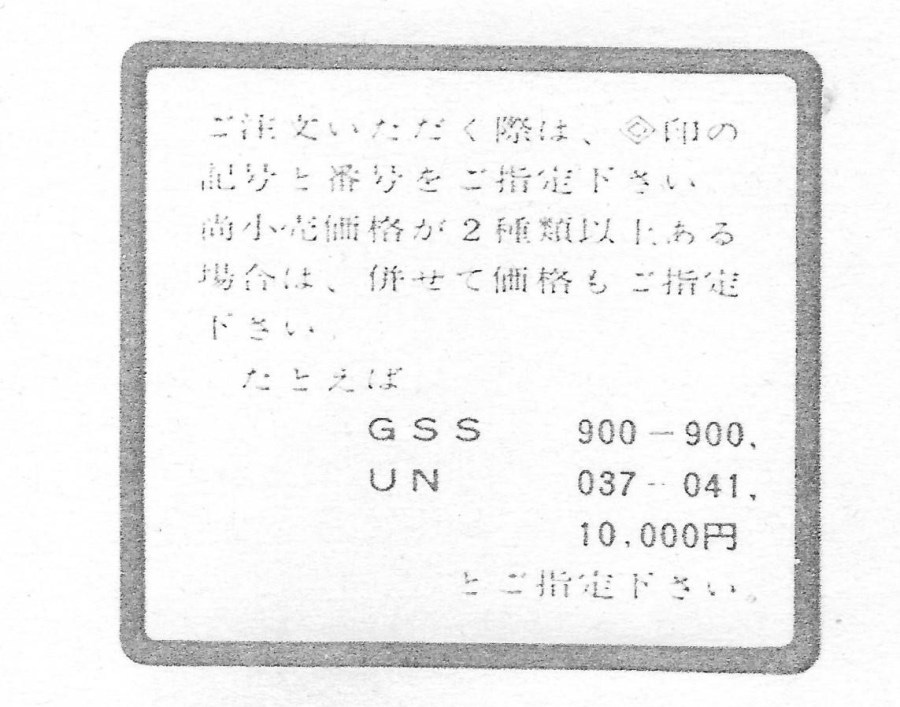The Seiko 1966 no. 1 supplement catalogue
Since originally publishing these catalogue articles on TGSG website, I have managed to almost complete my collection of Seiko catalogues from the 1960’s and 1970’s, and am just missing three of the extremely rare Seiko Special Luxury Catalogues.
There is just a single image of a Grand Seiko reference in this catalogue, and it is used to represent two variants from the 57GS series – the steel cased 5722-9991, and the cap gold cased 5722-9011
Grand Seiko 5722-9991 and 5722-9011
Even with very low resolution images such as the one provided in this catalogue, it is usually possible to identify exactly which of the four main stainless steel variants of the 57GS series (43999 SD dial, 43999 AD dial, 5722-9990, 5722-9991) are being represented in the photographs.
Identifying the 5722-9991 is the simplest of all, because the main dial layout was changed as Seiko were no longer ‘permitted’ to use the word “Chronometer” to promote their watches. Clearly from the image above, there is no text directly below the applied SEIKO logo, and so we know this is the final iteration of the 57GS series.
One slight oddity about how this reference is represented is that the catalogue code for the reference is given as GSC 901 901.
“GSC” identifies the watch as “Grand Seiko Calendar”. Note that this is a change from the original 1966 volume 1 catalogue, where the watch featured is identified as “GSS”, which is short for “Grand Seiko Self-dater”. Catalogue code structure would continue to evolve over the coming years, but Seiko did stick with using a “C” suffix to identify a watch with a date indication, and a “W” suffix to identify a watch with day and date indications from hereon in. 901 901 then indicates the case and dial codes for the specific reference.
It is somewhat odd that the case and dial codes are listed as both being 901 (the final digit of the codes is – for some reason unknown to us – always dropped from the catalogue descriptions). The reason that it is odd is that the correct case and dial codes of this reference are 9990 for the dial (the 5722-9991 has the same dial code as the 5722-9990, although the text is laid out differently around the 6 o’clock marker), and 9991 for the case.
The mystery is somewhat resolved when we note that this catalogue doesn’t just introduce the 5722-9991, but also the cap gold cased reference 5722-9011. The cap gold reference has a dial code 5722-9010, and hence would be identified in the catalogue as 901 901.
The stainless steel cased reference was priced at 27,000 Yen, and the cap gold at 33,000 Yen.
Placing orders
The catalogues were used by retailers to identify the watches they wanted to place orders for. Given that the same catalogue code could be used for multiple variants of the same watch, it wasn’t sufficient to simply provide the catalogue code when placing an order. Thus, the clear instruction to retailers was to use both the catalogue code and the price of the reference when placing an order.
Although I don’t show this instruction in the scan presented here (it appears on a different page of the catalogue), you can see it in a highlighted box on the scan of the 1966 volume 1 catalogue posted in the previous article. I show that box below for ease of reference.
Things get rather complicated…
The 5722-9011 wasn’t the first example of a cap gold cased 57GS series watch, although this catalogue is the first time a cap gold cased 57GS series watch is featured in a catalogue.
And this is where things get rather strange.
If we look back to the 1966 volume 1 catalogue, we can see that the steel cased 5722-9990 is featured, but there is no sign of its cap gold cased companion, the 5722-9010. Not too much of an issue – it wouldn’t be the last time that a cap gold cased reference was missing from the library of catalogues (the cap gold cased 44GS never featured in any catalogue).
But when we come to look at what is featured in the next catalogue – the rather confusingly named 1967 volume 2 – we will find both the 5722-9990 and 5722-9010 featured. As we will see in the next newsletter, the photograph used is obviously that of the earlier watch, and the catalogue code provided is 57GSC 010 (999-999/901-901).
The supplement to the 1967 volume 2 catalogue only introduces the 44GS series, but the next “full” catalogue – volume 1 of 1968 – switches back to showing an image of the 5722-9991, and provide catalogue code 57GSC 010 (999-999) for both stainless steel and cap gold cased variants.
Confused? Just think what it must have been like for Grand Seiko retailers back in the day, and the poor people at Seiko who had to deal with incoming orders!
Below is presented a table that details all appearances of the 57GS series in the Seiko catalogues from 1966 through to 1968, along with the catalogue codes. Hopefully if you have made it this far through without your head exploding, you will understand why I prefer to reference the different vintage Grand Seiko models by using their movement-case codes rather than their catalogue codes!
A conjecture on catalogue numbering
To the best of my knowledge this catalogue is the only example of “Volume 1” or “Number 1” of a catalogue for a particular year having a supplement.
This, coupled with the facts that
(a) having searched (including going through the archives at the Seiko Museum in Tokyo) for many years for the existence of 1966 volume 2 and 1967 volume 1 catalogues with no success; and
(b) not being able to trace the existence of any earlier catalogue from the 1960’s;
leads me to the following hypotheses.
Seiko commenced with a new series of catalogues starting in 1966, with Volume 1 of 1966 being the very first of the series
The initial intent was to number the catalogues sequentially, so 1966’s catalogue would be “Volume 1”, 1967 would be “Volume 2”, 1968 would be “Volume 3”, etc. This theory is strongly supported by the fact that, as we shall see in a later post, the 1967 “Volume 2” catalogue does not actually state the year 1967 on the cover.
From 1968 onwards, Seiko changed the numbering system of the catalogues so that there were two volumes (plus sometimes a supplement to the second) published each year, and the catalogues were identified by both the year of publication, and the volume within that year.
Based on the above, I do not believe anyone will ever find a “1966 volume 2” or “1967 volume 1” catalogue.
Gallery
In the gallery below I present a scan of the single page from the Seiko 1966 volume 1 supplement catalogue that features Grand Seiko references.








